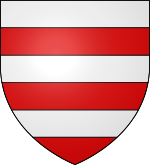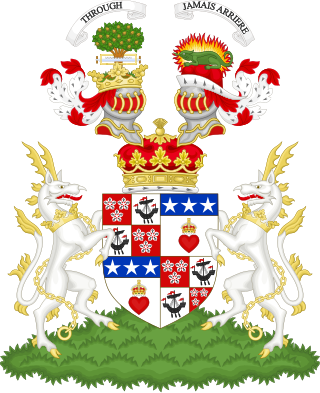
Duke of Hamilton is a title in the Peerage of Scotland, created in April 1643. It is the senior dukedom in that peerage, and as such its holder is the premier peer of Scotland, as well as being head of both the House of Hamilton and the House of Douglas. The title, the town of Hamilton in Lanarkshire, and many places around the world are named after members of the Hamilton family. The ducal family's surname, originally "Hamilton", is now "Douglas-Hamilton". Since 1711, the dukedom has been held together with the Dukedom of Brandon in the Peerage of Great Britain, and the dukes since that time have been styled Duke of Hamilton and Brandon, along with several other subsidiary titles.

The title Earl of Morton was created in the Peerage of Scotland in 1458 for James Douglas of Dalkeith. Along with it, the title Lord Aberdour was granted. This latter title is the courtesy title for the eldest son and heir to the Earl of Morton.

Bothwell Castle is a large medieval castle, sited on a high, steep bank, above a bend in the River Clyde in South Lanarkshire, Scotland. It is located between Bothwell and Uddingston, about 10 miles (16 km) south-east of Glasgow. Construction of the castle was begun in the 13th century by the ancestors of Clan Murray, to guard a strategic crossing point of the Clyde. Bothwell played a key role in Scotland's Wars of Independence, changing hands several times.

Hermitage Castle is a semi-ruined castle in the border region of Scotland. It stands in the remote valley of the Hermitage Water, part of Liddesdale in Roxburghshire. It is under the care of Historic Scotland. The castle has a reputation, both from its history and its appearance, as one of the most sinister and atmospheric castles in Scotland.

Archibald Douglas, 5th Earl of Angus was a Scottish nobleman, peer, politician, and magnate. Tradition has accorded him the nickname Archibald 'Bell-the-Cat' due to his association with the 1482 rebellion against James III of Scotland. He became one of the most powerful nobleman in Scotland through his influential position on the Scottish Marches, and a willingness to be involved in multiple rebellions in the reigns of James III and James IV of Scotland.
Patrick Hepburn, 1st Earl of Bothwell was Lord High Admiral of Scotland. He rose to political prominence after supporting James IV against his father, and was proxy at the King's marriage.
Adam Hepburn, Master of Hailes was Sheriff of Berwickshire in April 1467, and had a charter of confirmation of Dunsyre in the sheriffdom of Lanarkshire, dated 13 October 1475, being thereafter designated 'of Dunsyre'.
Sir Patrick Hepburn of Dunsyre, 1st Lord Hailes was the feudal lord of Hailes and its castle in East Lothian and a Lord of Parliament.
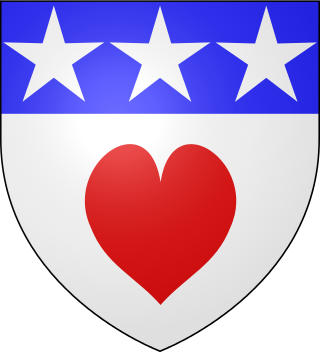
This page is concerned with the holders of the forfeit title Earl of Douglas and the preceding feudal barons of Douglas, South Lanarkshire. The title was created in the Peerage of Scotland in 1358 for William Douglas, 1st Earl of Douglas, son of Sir Archibald Douglas, Guardian of Scotland. The Earldom was forfeited by James Douglas, 9th Earl of Douglas, in 1455.

The Lord Warden of the Marches was an office in the governments of Scotland and England. The holders were responsible for the security of the border between the two nations, and often took part in military action. They were also responsible, along with 'Conservators of the truce', for administering the special type of border law known as March law.

James Hamilton, 1st Earl of Arran and 2nd Lord Hamilton was a Scottish nobleman, naval commander and first cousin of James IV of Scotland. He also served as the 9th Lord High Admiral of Scotland.

Liddesdale, the valley of the Liddel Water, in the County of Roxburgh, southern Scotland, extends in a south-westerly direction from the vicinity of Peel Fell to the River Esk, a distance of 21 miles (34 km). The Waverley route of the North British Railway runs down the dale, and the Catrail, or Picts' Dyke, crosses its head.

Clan Douglas is an ancient clan or noble house from the Scottish Lowlands.
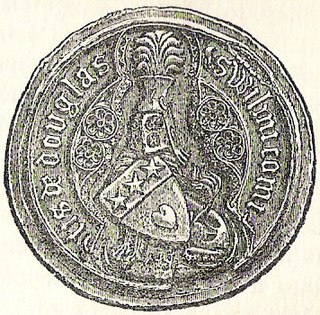
William Douglas, 1st Earl of Douglas was a Scottish nobleman, peer, magnate, and head of the Black Douglas family. Under his leadership, the Black Douglases continued their climb to pre-eminence in Scottish politics begun under his uncle, Sir James the Good, as well as their military dominance of the south of Scotland.
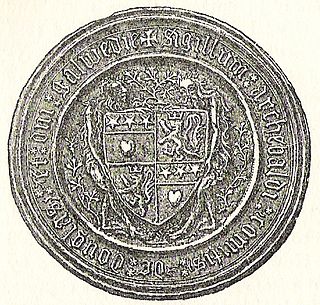
Archibald Douglas, 4th Earl of Douglas, Duke of Touraine, was a Scottish nobleman and warlord. He is sometimes given the epithet "Tyneman", but this may be a reference to his great-uncle Sir Archibald Douglas.
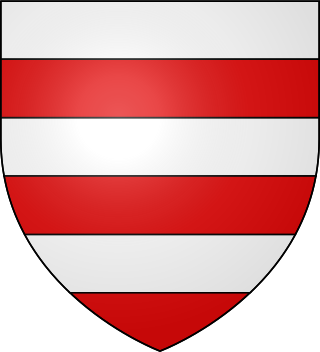
William II de Soules, Lord of Liddesdale and Butler of Scotland, was a Scottish Border noble during the Wars of Scottish Independence. William was the elder son of Nicholas II de Soules, Lord of Liddesdale and Butler of Scotland, and a cousin of Alexander Comyn, Earl of Buchan. He was the nephew of John de Soules, Guardian of Scotland.
Sir Archibald Douglas was a Scottish nobleman, Guardian of Scotland, and military leader. He is sometimes given the epithet "Tyneman", but this may be a reference to his great-nephew Archibald Douglas, 4th Earl of Douglas. He fought and died at the Battle of Halidon Hill.

Clan Eliott is a Border Reiver Scottish clan.

Sir William Douglas, Lord of Liddesdale, also known as the Knight of Liddesdale and the Flower of Chivalry, was a Scottish nobleman and soldier active during the Second War of Scottish Independence.
George Douglas, Master of Angus was a Scottish Nobleman. The son of Archibald Douglas, 5th Earl of Angus and Elizabeth Boyd, daughter of Robert Boyd, 1st Lord Boyd, he was born at Tantallon Castle and died at the Battle of Flodden.

